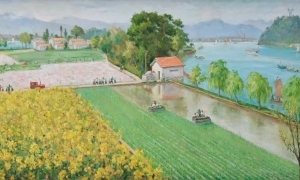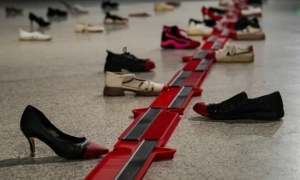农转非特写:赵晓东笔下的农民工
王小箭
“农村包围城市”的成功决定了“表现工农兵英雄形象”的“政治正确性”,于是,工农兵形象成了“意气风发,斗志昂扬”的“红光亮”和“高大全”。由于属于同等政治概念的图解,因此工农兵之间的差异只在于装束不同,甚至连男女的面相也都是双胞胎。这种统一脸谱的现象在传统艺术中是常见的事情,法国的罗可可艺术和中国京剧艺术都把“美男”女性化到与女人成为统一脸谱的程度。“红光亮”之后的“乡土写实绘画”把农民还原到“锄禾日当午”的状态,但恰恰在这一时期,首先实行所有制改革的农村却成为中国先富起来的人群,尽管当时富的标准无法与今天相比,但农民的生活的确得到了极大的改善,一些乡镇企业办的好的地方,农民的日子甚至比城里人还好。“菜篮子工程”这个概念可以作为彼时都市生活水平的缩写。
随着农村体制改革经验在城市的推广,农村逐渐失去了政策优势与先发优势,城市对农村的优势日益明显,越来越多的农民离开世代耕耘的土地,到大城市谋生,乃至成为“春运”的最大麻烦。“农转非”成了中国社会的时代特征真切写照,“农民工”成为政府和媒体的常用词,“农民工”问题和“三农”问题成了“农转非”过程中的中国社会的突出的问题。一旦进入城市,成为农民工,“锄禾日当午”的价值就没有了,同样辛勤的汗水换来的是“底层人文”的劳动条件与社会地位以及比农村还差的居住环境。同时,“农转非”必然带来的观念变化最终把“农民”变成了愚昧无知、固执保守的代名词。因此,早在政治波普和艳俗艺术中,农民就已经成为滑稽可笑的角色。正是在这种历史背景下,赵晓东选择了农民工作为自己艺术创作的源泉。
重庆的农民工可以统称为棒棒,这并不是他们其他事情都不做,而是因为手中的棒棒是他们最突出的标志。棒棒和其他城市的农民工的最大不同是他们并不集中于加工厂或建筑工地,而是散落在城市的大街小巷,居住在城市的各个角落。从赵晓东工作室出来往坡下走,一路上都是简陋的棒棒住房,赵晓东说他每天都能看见上来下去的棒棒,这也是他在这里租工作室的原因。但是环境并不仅仅是一个取材方便问题,它同时也在逐渐拉近艺术家与表现对象的距离,影响着艺术家对表现对象的态度。赵晓东近年的作品有一个明显的过度,那就是从略带讥笑的猎奇变为同情再变为人性解读,表现在他的作品中,就是从突出场景、情节、装束、表情之类的外在特征,变为焦聚面部的无助忧郁的表情,再到近乎于身份证照片的肖像画。讥笑和同情都是居高临下的态度,区别只在于恶意与善意,人性的解读就不存在居高临下的问题了,而是认真的观察与揭示。当然这并不意味着作品排除了艺术家的主观性,因为毕竟是赵晓东的观察与赵晓东的揭示。下面是我摘录的几段赵晓东的艺术笔记,从中可以大致看出这种变化。
关注他们的生存状态,记录下这群建设者的生活,希望传达出经得起推敲的情感,刻意从残破中发掘出美和爱。用淋漓、酣畅的笔触来表现他们灵魂的印记。我想最重要的是描画出“真实”的景象…使作品营造出异样的氛围,显现出盎然生气,象征性地展现了农民工对未来生活的追求,同时又显得有些迷惘。
2005年3月
也许都会觉得这群人活得好累,可我发现他们活得很轻松、很洒脱,光着榜子干活,相互开着“荤”玩笑。和他们站在一起明显使我们不自然,不协调。当今许多作品都在表现民工劳动的场景,反映他们的辛酸生活,突显人道主义的光芒,而似乎少了一些真正、完整记录这群人的作品,他们同样快乐生活、同样喝酒高歌。
2007年8月
画了《挑砖》系列作品后发现没有背景很好,很干净,画面的注意点全在民工本身了,肌肉的色彩,衣裤的表现比较自由了,人物表情隐退了。但还需要在边缘线处理上的突破,紧张与松动的关系,不能仅体现在笔触和肌理中。
2007年11月
我之所以强调赵晓东从记录到同情再到揭示的演变过程,并不是说这个过程的前两步没有价值,而是想说明关注人性本身的肖像画在中国艺术中相对于情节性、思想性、观念性人物画来说是一个弱项,之所以成为弱项是因为中国的艺术思想体系得不到价值确认,在这种情况下艺术家的近期作品很容易被认为是一种退步。
西方写实艺术对中国的影响主要是人物题材作品的创作,但肖像画的影响远不如主题性、情节性绘画。“大脸”不属于严格意义上的肖像画,而是主题性绘画的局部特写版。严格意义上的肖像画是体现人物面部一般性特征,也就是说不是他的某一时刻的某一种状态或表情,而是体现此人之为此人的相貌特征。最接近这种理念的是证件照片,在这种照片中,人物不与任何场景、情节、感情发生联系,虽然也是一张“大脸”,但不负载任何观念,天安门的城楼和广场上的领袖像就是他们照片的放大,伟人感是由于位置和他们在观众(群众)心中的地位,而不是由于形象本身。正因如此,摄影的产生才能导致肖像画的衰落,但只有好的人像摄影能达到肖像画的水平,这是因为摄影经常正好错过的最能代表次人最一般的特征的那一瞬间,所以我们经常看到“不像”或“不太像”的照片,而肖像画则由于艺术家可以避开所有不代表此人的瞬间而表现出此人的一般特征。赵晓东的近作和他过去的作品的最大不同就在于从情节化、观念化变为肖像画,从捕捉人的偶然性变为塑造人的必然性。
我曾经在一篇文章中提到过中国画追求的是“活性”(vitality, vivacity),无论是画论中“以形写神”、“气韵生动”、还是通俗的“虎虎有生气”、“生龙活虎”、“活灵活现”、“一气呵成”,强调的都是“活性”。西方则强调事物的本质,既然“现代性”是现代的本质,“动物性”是动物的本质,那么“人性”当然就是人的本质。本质就是必然性、一般性,因此必然排斥一切偶然因素,具体到人像上,就是只记录谁,不记录在哪里,干什么,高兴还是忧愁,因为这些对于一个人来说,都是偶然的。在中国美术教育,有头像写生训练,训练的目的不是画肖像画即人性或人的必然性,而是画]情节性、思想性或观念性,也就是人的偶然性。因此展出与出版的头像要么属于教学成果和学习样板,要么属于艺术家的图象笔记,总之,不是正规作品。之所以形成这种状况,显然与中国追求“活性”传统排斥追求本质的西方传统有关,当然还有其他原因。
赵晓东的近作就是贴近农民工的必然性,这是呈现出来的更多的是表现对象的人性本身。对于中国人和中国艺术来说,这是一个认识的盲区,文学的情况也好不了多少,在这样一片贫瘠的土地上耕耘显然是困难的。至于本质论受到西方现代哲学的挑战,那是西方的事情,中国需要的是建立本质论,具体到人物题材的作品来说,就是揭示人性,而不是只会讲述人的奇遇故事或者特殊遭遇。
A Close-Up to the Agriculture-to-Non-agriculture Transfer
— Peasant Workers Created by Zhao Xiaodong
by Wang Xiaojian
The success of “Encircling the Cities from the Rural Areas” has determined the “political correctness” of “the presentation of the heroic images of workers, peasants and soldiers”, and the images of them have become “enthusiastic and glamorous perfections in high spirits”. Belonging to the same political concept, workers, peasants and soldiers are different only in their clothes and even the males and females of them look alike. This phenomenon of uniformity is not uncommon in traditional art; it can also be found in Rococo of France and Beijing Opera, both of which feminize the images of males to unify the images of both genders as a whole. Local realist paintings produced after the presentation of the “glamorous perfections” reduced the peasants to the original state of “farming under the sun”, while at that time, the peasants were among the first group of Chinese people who became better-off with the implementation of ownership reform. Although the standard of a well-off life could not be compared to that of the present days, the life of peasants had been improved greatly; in some rural areas where the township enterprises prospered, the peasants lived even better than the urban citizens. The concept of “Vegetable Basket Project”- a project aiming at promoting the supply of vegetables and fruits to the cities from the rural areas- could be the epitome of the living standard at that time.
With the extension of the system reform from rural areas to cities, rural areas gradually lost its first-mover advantage and the advantage in policy. Cities have exceeded rural areas in many ways,
which impels peasants to leave their land and make a living in big cities, making “Spring Transportation” a big problem. The “agriculture-to-non-agriculture transfer” reflects the characteristics of Chinese society and the phrase “peasant worker” is frequently used by government and media. The issue of “peasant workers” and “three agricultures” has become a controversial problem of Chinese society in the process of the “agriculture-to-non-agriculture transfer”. Once entering the city and becoming one of the peasant workers, a peasant has lost his value as a traditional peasant. His labor can only buy him working conditions and social status at the bottom and a living condition which is even worse than that in the rural areas. At the same time, the change of ideas brought about by the “agriculture-to-non-agriculture transfer” will ultimately make the word “peasant” a pronoun for ignorance and obstinacy. That’s why peasants have been playing a ridiculous part in the political pop art and the gaudy art long before. Zhao Xiaodong chose peasant as his mine of artistic creation under this historical background.
Peasant workers of Chongqing are called “bangbang” – a nickname originally referred to porters. However, it doesn’t mean that they do nothing else; they are called “bangbang” because the carrying poles are the most significant signature of them. The biggest difference between “bangbangs” in Chongqing and peasant workers in other cities is that they do not gather around factories or construction fields like peasant workers in other cities do; instead, they scatter in every corner of the city. Go out of Zhao Xiaodong’s studio and go down the slope, one can see simple houses for “bangbangs” all the way. According to Zhao Xiaodong, he can see “bangbangs” going up and down everyday, and that’s why he rent his studio here. But the choice of environment is not only about convenience; it is also getting the artist closer and closer to his expressive objects, influencing the artist’s attitude toward his expressive objects. There is an apparent transition in Zhao Xiaodong’s recent works, from the sarcastic seek of novelty to sympathy, then to the interpretation of human nature, which is reflected in his works by the transition from the emphasis on the external features such as scenes, plots, clothes and expressions, to the concentration on the melancholy facial expressions, then to the ID-picture-like portraits. Both irony and sympathy are attitudes harbored from a higher place, the only difference of which is whether it is out of malice or goodwill; while the interpretation of human nature is a careful observation and exposure. Of course this does not mean that the works have excluded the artist’s subjectivity because, after all, the observation and exposure belong to Zhao Xiaodong. Several art notes written by Zhao Xiaodong are quoted here, from which we can roughly see this transition:
I’ve tried to pay close attention to their living state, recording their life to convey a convincing emotion and purposefully find love and beauty from dilapidation. Passionate and forceful strokes are used to represent their spirit. To me, the most important thing is to depict the “real” scenes…to create a fancy environment filled with vigor, symbolically representing the pursuit of the peasant workers’ future life with a sense of perplexity.
March, 2005
People may assume that they are leading a hard life. I, on the other hand, find them living in comfort and ease — working bareback and making fun of each other. Standing with them, we will appear to be unnatural. Many works today concentrate on the presentation of the peasant workers’ hard work and bitter life with sympathy out of humanitarianism, while works genuinely and completely recording all the aspects of their life seem to be scarce. Actually they are also living happily, singing and drinking.
August, 2007
After completing the series “Tiao Zhuan (carrying bricks)”, I’ve found that paintings with no background look nice and clean, leaving the workers themselves the only focus. The color of the muscles and the clothes are executed with more freedom, while the facial expressions have receded. However, a breakthrough on the execution of border lines is expected, because the relationship between tensity and looseness shall not be only presented in strokes and textures.
November, 2007
By putting much emphasis on Zhao Xiaodong’s artistic transition from recording to sympathy, then to exposure, I’m not saying that the first two stages are worthless. What I’m trying to say is that, compared to the paintings concentrating on plot, thought and concept, portraits concentrating on human nature is a weak aspect in Chinese art, because the value of Chinese artistic ideological system is not widely acknowledged. Under this circumstance, the recent works of the artist may easily be deemed as a kind of regress.
Western Realism has influenced Chinese art mainly in the production of figure paintings; the influence on portraits is far less than that on theme or plot paintings. Paintings of “big faces” are not portraits in the strictest sense, but a partial close-up of the theme paintings. Strictly speaking, a portrait presents the general features of the figure painted, not a certain state or expression at a certain time. ID pictures are closest to this idea, in which figures are not connected to any scene, plot or emotion – “big faces” with no external burden. Leaders’ photos hung up in public places are amplified versions of their original photos, and their greatness lies in the position of the photos as well as their status in the audience’s (people’s) heart, not in the image itself. That’s why with the emergence of photography, portraits gradually declined. However, only a good photographer can take pictures up to the level of good portraits, because photographers may miss the very moment when the general features of a person is best reflected. That’s why we often see that a figure in the photo is not much like the person him or herself. Portrait painters, however, can present the general features of a person by evading all the untypical moments. The most significant difference between Zhao Xiaodong’s recent works and his earlier works is the transition of focus from plot and concept to portrait, from contingency to necessity.
I once mentioned in one of my articles that Chinese painting pursues “vitality and vivacity”, while Western painting emphasizes the nature of things. Since “modernity” is the nature of modern times, and “animality” is the nature of animals, “humanity” is of course the nature of human being. Nature is all about necessity and generality, excluding all the accidental factors. When it is applied to the production of portraits, painters only record who the object is instead of other accidental factors such as where he is, what he is doing, or whether he is happy or not. In Chinese art education, the purpose of the training of portraits concentrates on the plot, concept or idea – that is to say, the contingency – not human nature or its necessity. Hence, the portraits at exhibitions or published are either teaching achievements/ learning models, or sketches of the artists, not belonging to the category of formal works. This is mainly because of the Chinese pursuit of “vitality and vivacity” and its rejecting the Western tradition of the pursuit of nature, although other reasons cannot be precluded.
The recent works by Zhao Xiaodong is the inevitable result out of his involvement with peasant workers, which more reflect the humanity of the observed. To both the Chinese and Chinese art, it is a blind area of understanding, and the condition is no better in literature. To grow in such a barren field is apparently difficult. Although the essential theory is being challenged by modern Western philosophy, what China needs is to establish the essential theory, which can be applied to the production of figure paintings in order to reveal human nature other than telling adventurous or special experiences of others.
【编辑:霍春常】






















